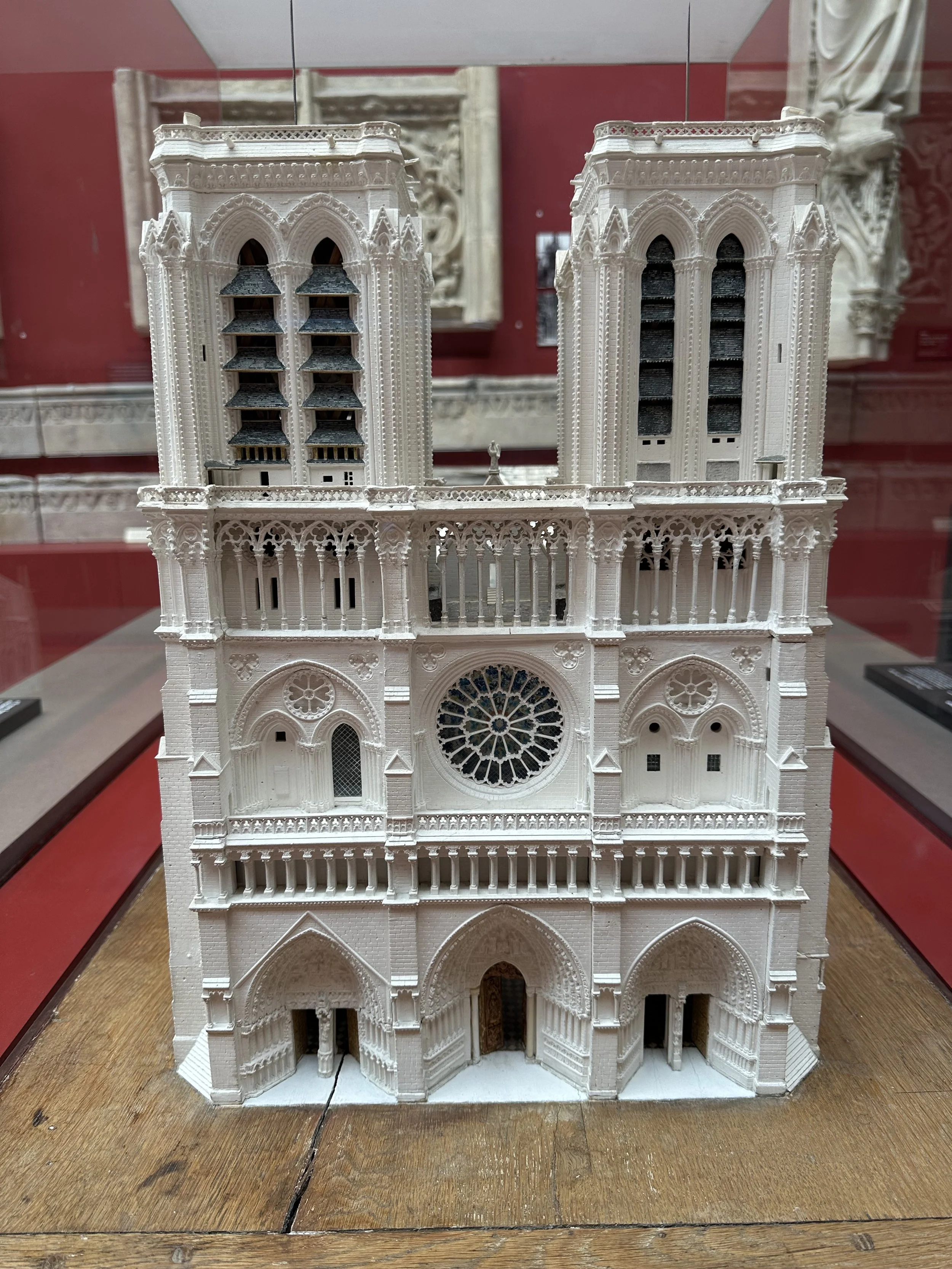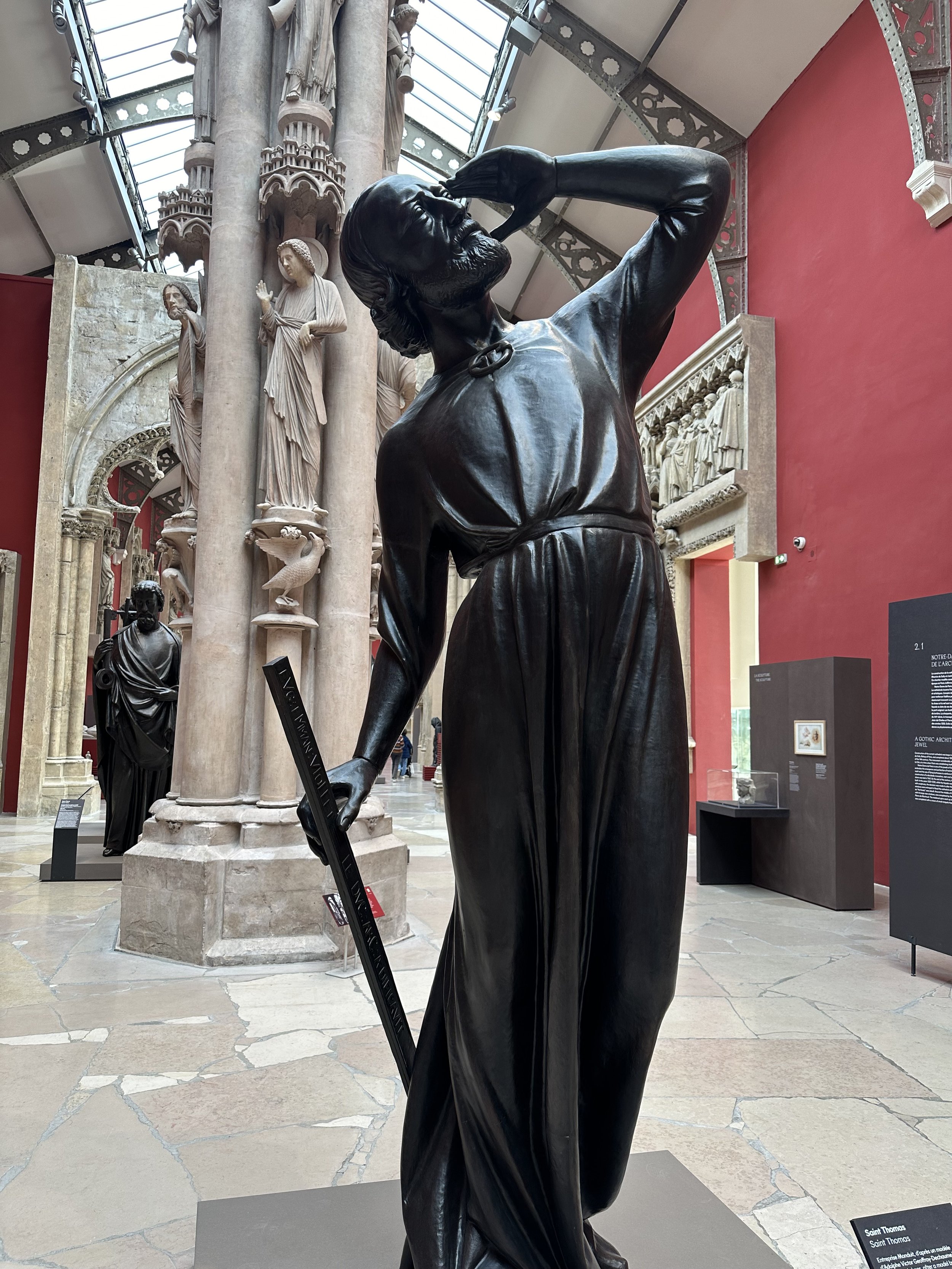On the night of April 15, 2019, as we watched the flames reach the sky from the roof of Notre Dame de Paris it was hard not to be heartbroken. The cathedral of Paris belonged to the entire world and there was a collective gasp as we watched and hoped for the best.
In an unbelievable stroke of luck just four days before the fire the statues of the roof were removed one by one. On April 11, 2019, the twelve apostles and four evangelists flew over the streets to head south for a bit of a freshening up. The plan was to return them two by two to Notre Dame to be placed on display before their return to their roof. The plans changed but we are very lucky they can now be seen up close, an opportunity that you don’t want to miss.
In 1795, my hero Alexandre Le Noir jumped into action to save the monuments of France that were on the path of destruction by the Revolution. The tombs of the kings and queens in the Basilique Saint-Denis would have been lost if not for Alexandre. The rescued monuments made their way to the Ecole des Beaux-Arts and became the first Museum of French Monuments. It lasted until 1815 when the contents were returned to their rightful homes Emmanuel Viollet-Le-Duc, an architect who played a major part in Notre Dame had a dream to recreate the museum and in 1879 it was revived and opened at the Trocadero.
Filled with the casts of French churches and monuments it was the perfect home for the statues of Notre Dame until they could return to their peak over the Seine.
In 1842 Viollet-le-Duc and Baptiste Lassus were selected to rehabilitate the grand lady. His early plan included the addition of two spires on the roof. The former spire had been removed in 1797 for safety issues and an entire generation never knew the church with a spire. Coming off the renovation of Sainte Chapelle, Viollet-le-Duc wanted to add statues to the roof and tapped Adolphe Victor Geoffroy-Dechaume who he had worked with on Sainte Chapelle.
Work began on the Apostles in 1848 and they were a bit more than meets the eye. The inner structure was created with iron and then covered with copper sheets making for a much lighter statue that could stand far above the streets. In the Périgeux offices of SOCRA, the statues arrived and the work began. Many of the internal structures had to be partially replaced. Micro-sandblasting with apricot powder the outer layer of the patina was removed. A dark bronze colored paint was added and coated with wax and after a month of work, the statue was complete.
There are 16 total statues, twelve Apostles and four Evangelists and they can all be found in the rarely visited Cité de l’Architecture & Patrimoine. There are four different body types and Dechaume then made each unique with its head, hands, and attributes.
Saint Pierre (Peter), is of course holding a key as he is always depicted in almost every church you will ever enter. Waiting at the gates of heaven, the “Prince of the Apostles” is the first you'll also encounter as you walk in. Saint Pierre is the patron saint of clockmakers, locksmiths, foot problems, and Las Vegas as well as a very long list of others.
Saint Matthieu (Matthew) A former customs officer and tax collector who left to follow Jesus also wrote the first gospel. The open book he holds is a nod to that. Matthieu is the patron saif of accountants, Italians, and perfume makers.
Saint André (Andrew) The brother of Saint Pierre, he was a fisherman and one of the first disciples chosen. Sentenced to death by dying on the cross he asked that his cross be different from the one Jesus was crucified. A cross in the shape of an X was created and he magically attached to it instead of having to be nailed. Today he is the patron saint of fishermen, singers, pregnant women, and Scotland which uses the cross of Saint Andrew as its flag.
Saint Jude has The same body as Saint Thomas he is without any attributes.
Saint Simon In this statue he is holding a book but is often seen holding a long saw that was the instrument of his death.
Saint Bartholomew The first statue to be restored, is holding a knife to signify his rather gruesome death. He had been skinned alive and beheaded and now is the patron saint of butchers and leather workers, which is a bit gruesome. On a lighter note, he is also the patron saint of cheese and salt merchants.
Saint Jacques Le Mineur (James the Younger) Holds a club that he was killed with, often depicted with stones that he was struck with.
Saint Paul Once the persecutor of Christians had a divine revelation and converted and became a preacher. Killed in 64AD with a sword that cut off his head, he now rests his hand on a sword and strokes his beard.
Saint Jacques Le Majeur (James the Major) At the scene of many of the most important events he was one of the closest disciples of Jesus. He preached through Spain and was the first to be executed in 44 AD. His name is given to the pilgrimage walk, the Compostela, and can be seen with a walking stick. He also gives his name to scallops and is the patron saint of Spain, Seattle, pharmacists, and oyster fishermen.
Saint Jean (John) The youngest and beardless one is always easy to spot. One of the most loyal Apostles, he holds a cup that signifies his miracle of drinking poison and surviving.
Saint Philippe Holds the cross from which he was killed and is the patron saint of pastry chefs and hat makers.
At the base of each cardinal point leading to the spire is one of the four evangelists in the form of four living creatures. Each is in the same pose and has their heads turned towards the saints that look below.
The Eagle of Saint Jean, the Angel of Saint Matthieu, the Lion of Saint Marc, and the Ox of Saint Luc.
The last saint you will find has a special added touch. Saint Thomas, the patron saint of architects, takes on the physical appearance of Viollet-le-Duc. Dechaume also added the architect's name to the ruler that he holds out from his right side as his left arm is raised. Unlike the other 11 statues of the Apostles, Saint Thomas turns to look up at his spire.
I am relieved that he didn’t have to see his beloved spire burn on that early spring evening.
Also on sight is the miracle rooster that once crowned the spire. As the fire ate away at the fleche, all I could think of was the rooster that held three precious relics. When the spire could no longer hold itself up it crashed into the transept of the church and the rooster was thought to have perished. The next day, architect Philippe Villeneuve was photographed holding the battered rooster with the relics still safely inside.
Those precious relics include a piece of the Crown of Thorns. A relic of Saint-Denis, the 3rd-century patron saint of Paris was beheaded and walked five miles holding his head. And a relic of Sainte Genevieve, the patron saint of Paris who saved the city numerous times during her life and many times in the 1600 years since her death. I think she did it once more on April 15, 2019, saving the beloved Notre Dame from destruction.
Be sure to visit the Cité de l’Architecure & Patrimoine when you are next in Paris. Located at the Trocadero, just across from the Eiffel Tower it is open Wednesday - Monday 11 am - 7 pm, and Thursday 11 am - 9 pm.
The special exhibition runs until September 2, 2024 and a few pieces may leave even sooner as the restoration moves forward to the reopening of December 8, 2024







